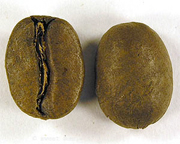 “Microroasting.” It sounds like something that might go on in the diffusion oven of a small fab. But actually, I’m talking about coffee. It is totally off topic, but then it’s Friday. I’ve been learning how to talk “coffee roasting.” My brother in London owns a couple of coffee roasting machines. A friend Matthew Michels at Tuscany, roasts his own coffee. The hippest coffee shops in the San Francisco Mission District, Ritual Roasters and Four-barrel Coffee, roast all their own beans. Blue Bottle Coffee, whose coffee shops contain strange types of glassware to make coffee in ways you’ve never tried, roast all their own beans. They are all “microroasters” who roast small batches of high-quality coffee from single farms; Starbucks and Peet’s only manage to have a country of origin since they need such large quantities. If you go to a ball game in San Francisco or come up to the city by Caltrain, then the Creamery, just across the road from the Caltrain station, also serves Ritual Roasters coffee (and it’s just a block from where I live which is really convenient). The quality of the coffee at any of these places is immeasurably better than the average restaurant espresso machine or Starbucks. The first time you have a well-made espresso made from perfectly and recently roasted beans it is a revelation.
“Microroasting.” It sounds like something that might go on in the diffusion oven of a small fab. But actually, I’m talking about coffee. It is totally off topic, but then it’s Friday. I’ve been learning how to talk “coffee roasting.” My brother in London owns a couple of coffee roasting machines. A friend Matthew Michels at Tuscany, roasts his own coffee. The hippest coffee shops in the San Francisco Mission District, Ritual Roasters and Four-barrel Coffee, roast all their own beans. Blue Bottle Coffee, whose coffee shops contain strange types of glassware to make coffee in ways you’ve never tried, roast all their own beans. They are all “microroasters” who roast small batches of high-quality coffee from single farms; Starbucks and Peet’s only manage to have a country of origin since they need such large quantities. If you go to a ball game in San Francisco or come up to the city by Caltrain, then the Creamery, just across the road from the Caltrain station, also serves Ritual Roasters coffee (and it’s just a block from where I live which is really convenient). The quality of the coffee at any of these places is immeasurably better than the average restaurant espresso machine or Starbucks. The first time you have a well-made espresso made from perfectly and recently roasted beans it is a revelation.
Basically the way you roast beans is to apply heat while they are tumbled until they reach the desired level of doneness, then you cool them down as fast as you can so they don’t continue roasting. One problem is that in the middle of the process, the chemical reactions that the heat induces in the coffee become exothermic, or an alternative theory is that once all the water has been driven off the temperature can rise uncontrollably fast. It is a major problem in roasting that you will have fires when the roasting process runs away.
 There are two critical points in roasting, known as first crack and second crack. These are points in the roasting when you can actually hear the beans crack and indicates a certain point in the roasting. Actually it is pretty hard to hear the cracks in a home roasting machine which noisly blasts hot air through the beans, but coffee roasters all talk about these points since they are well defined. Pros regard these, along with aroma, as a more useful way to assess doneness than color. Beans are roasted“to first crack is complete” or “until first snaps of second crack" and so on. So if you really want to bluff your way in coffee roasting, these are great terms to drop into the conversation!
There are two critical points in roasting, known as first crack and second crack. These are points in the roasting when you can actually hear the beans crack and indicates a certain point in the roasting. Actually it is pretty hard to hear the cracks in a home roasting machine which noisly blasts hot air through the beans, but coffee roasters all talk about these points since they are well defined. Pros regard these, along with aroma, as a more useful way to assess doneness than color. Beans are roasted“to first crack is complete” or “until first snaps of second crack" and so on. So if you really want to bluff your way in coffee roasting, these are great terms to drop into the conversation!
Green unroasted beans do not deteriorate for about a year. Roasted beans start to deteriorate almost immediately. For the ultimate in coffee you want beans roasted no more than a week or two earlier, and only ground just before the coffee is made. Once roasted, coffee beans produce carbon dioxide. You’ll find if you put freshly roasted beans in a ziplock bag that the bag starts to expand. In a fresh espresso, that gas coming out during the brewing process is what makes the characteristic crema on top of the coffee and gives it its beguiling aroma. Old coffee doesn’t do that.
If you want to know more, including lots of pictures of coffee beans through the process, then look here.
Then you grind the beans and make coffee, Ritual Roasters tell you more than you want to know in this video about how to taste coffee (known as “cupping”) or how to make the perfect espresso (21g of coffee and ¾ oz of water). Next time you are in the city, treat yourself to the ultimate cup of coffee.
